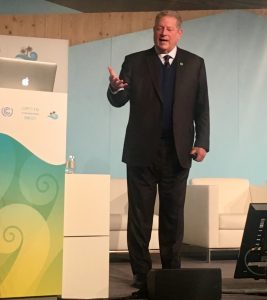The country that presides over the UNFCCC in a given year sets the tone and the agenda for the meeting. While their influence may be hard to pinpoint, it can determine the outcome of the conference. Disorganized leadership is one of the reasons often given for COP15 in Copenhagen being viewed as a disappointment. In contrast, the leadership of Laurent Fabius, the president of at COP21 in Paris, is highly applauded. He did an incredible job of setting hard deadlines and ensuring that all Parties felt included in the process. Spoiler alert: the landmark Paris Agreement came out of this negotiation, with 195 countries agreeing to the plan of limiting global temperature change to 2oC.
Fijian Influence
This year’s COP marked the first UNFCCC chaired by a small island developing state. Germany agreed to physically host the event since it had the infrastructure and capacity to do so, but the Fijian government presided over the conference. Despite being hosted in a damp and frigid European country, the Fijian culture and influence were felt throughout the conference. The opening ceremony of COP23 was a symbolic performance emphasizing the social justice aspects of climate change. The event opened with a song titled I am an Island. The bejeweled singer was led into the venue following a group of children holding climate action signs, with messages such as “save our planet.” This was a strong reminder that the decisions, or lack of decisions, made by the UNFCCC will have direct impacts on the fate of these children’s worlds. Next, there was a Fijian ceremony during which men in traditional garb offered a sperm whale tooth to the Environmental Mister of Germany, Barbara Hendricks. This ceremony only underscored the fact that the people of these state islands, who have contributed little to the anthropogenic climate change, are among the most vulnerable to its impacts. Continued sea level rise will directly impact the homes of these communities and their traditions. 
During COP23, I followed the topic of Loss & Damage (check out Tasfia’s blog posts for more information on the topic). Throughout the week, I heard many representatives from Least Developed Countries emphasize the need for financial mechanisms to properly prepare for and respond to loss and damage resulting from climate change. A reoccurring talking point of optimism at these events was that the concerns of vulnerable states would be higher on the agenda at this COP given that Fiji, a vulnerable state itself, was hosting the conference.
However, an interesting perspective I encountered at the negotiations was the concern that because Fiji is a developing country itself, other developing countries were less inclined to make rigorous demands on the host than has previously been the case with developed countries chairing the COP. While this type of sentiment is hard to prove, it is an example of how complicated UNFCCC dynamics can be. Something that seems like it will obviously influence the conference in one direction could actually have the reverse effect due to the complexity of international relations.
Looking towards Poland:
There is concern among environmentalists looking towards next year’s COP24 hosted by Poland. Poland is a notoriously coal-dependent state. In fact, as of 2015, 80.9% of the electricity produced in Poland was from coal sources. Thus, advancing the international agreements to cut back on fossil fuels is not exactly in line with its economic interests. Moreover, the current Polish administration is not particularly environmentally friendly. Therefore, the prospect of COP24 having an aggressive agenda towards combatting climate change is not looking all that promising. However, as has been proved in the past, it is hard to predict how COPs will actually play out.



